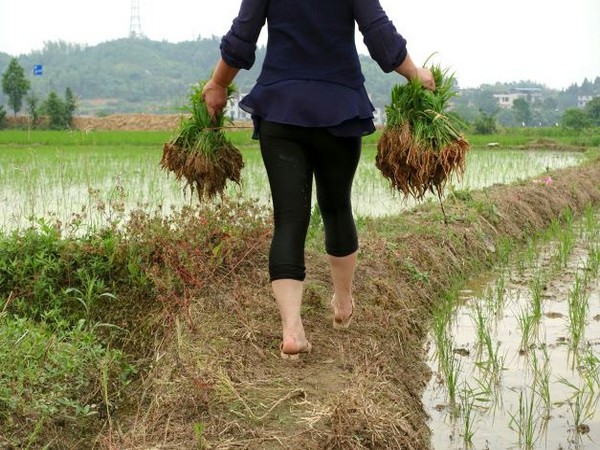New Delhi [India], March 4 (ANI): With a 1.4 billion population, China consume massive amounts of food, and securing it is the government’s biggest priority.
Food security and protecting farmland have of late become the top priority of China as it comes out of the Covid lockdown. The central committee of the Chinese Communist Party released the highly anticipated No 1 Document for 2023 last month, yet again underlining the importance of the two factors – growing population and prioritizing food security.
Official data claims that the Chinese consume a staggering 700,000 tons of grain, 98,000 tons of edible oil, 1.92 million tons of vegetables, and 230,000 tons of meat annually.
The leaders of the CCP no doubt realise that prioritizing food security is a prerequisite to maintaining power, especially after the calamitous famines of the Maoist era.
For decades, the Chinese were used to arranging coupons to buy any food–a system not fully ended until 1995 though it was obsolete in the urban areas by the late 1980s.
Still, since 2004 and definitely after 2013 under Xi Jinping’s leadership, the country’s No 1 Central document centred on food security and the inter-woven issues of agriculture, the countryside, and farmers.
The No 1 document marked Xi’s first policy statement as China’s top leader and laid out his roadmap for enhancing China’s food security in 2013. At its core was ensuring China’s national food supply to strengthen food self-sufficiency.
The document called for a robust supervision system to improve China’s food safety. It also unprecedentedly urged the need to “implement the most stringent farmland protection system and promote the development of high-standard farmland.”
Xi’s strategy is practical because China’s political system remains vulnerable to food insecurity. Amid the Covid-19 pandemic, public grievances aggravated by disruptions in the food supply and lockdown-induced food shortages sparked a wave of protests in more than a dozen cities, with demonstrators demanding food.
Given such alarming circumstances, Xi underscored that China’s growing dependence on imported food presents a national security concern, even though China so far has been able to feed its 1.4 billion people.
Since taking office in 2013, Xi has stressed that “the rice bowls of the Chinese people must always be held firmly in our own hand and filled mainly with Chinese grain”.
His idea of safeguarding national food security is to achieve self-sufficiency by increasing domestic supply. At the Central Economic Work Conference in December 2022, he highlighted the importance of bolstering China’s capacity to ensure food security and self-sufficiency.
China has experienced severe levels of farmland loss and deterioration in recent years. The latest land use survey showed that China’s total arable land decreased from 334 million acres in 2013 to 316 million acres in 2019, a loss of more than five per cent in just six years.
According to research published in Foreign Policy, “shockingly, more than one-third of China’s remaining arable land (660 million mu), a traditional unit of land measurement in China and equal to roughly 109 million acres, slightly larger than Montana) suffers from problems of degradation, acidification, and salinization”.
The annual decrease of arable land has risen from about 6 million mu (about 988,421 acres) from 1957 to 1996 to more than 11 million mu (about 1.8 million acres) from 2009 to 2019.
“This means that between 2009 and 2019, China lost farmland equal to about the size of South Carolina.”
China’s diminishing farmland is also losing productivity due to over-cultivation and excess use of fertilizers. China’s fertilizer usage in 2018 was 6.4 times that of 1978, but grain yield in 2018 was only 2.2 times that of 1978.
The primary cause of farmland deterioration is its land-intensive industrialization and urbanization over the past three decades.
Farmland was expropriated to meet the growing demand for land to support the expansion of manufacturing, infrastructure, and urban development. Competing interests for land use have resulted in arable land being expropriated for more lucrative development projects.
Grain accounts for 70 per cent of the total arable land. The rest is used for growing cash crops, gardens, forestry, or left fallow.
Research suggests that by the time China achieves an urbanization rate of 70 per cent by 2030, the country is likely to lose about 20 million mu (about 3.3 million acres) of high-quality arable land.
In March 2022, the government fixed criteria for high-quality farmland for different Chinese regions to develop 1.2 billion mu of high-quality farmland by 2030.
The state investment will raise to an annual average of 3,000 yuan per mu nationwide, which means an annual investment of at least 75 billion yuan for 2023-2030. But the current investment is hardly less than half the annual target.
Foreign Policy said, “Implementing restrictive farmland protection policies will inevitably reduce local governments’ fiscal capacity because revenue from land-use-right sales constitutes the majority of local government revenue–as it has done since fiscal reforms in the 1990s left regular tax income flowing toward the central government, not local authorities. In 2022, local governments’ land-related income fell for the first time in six years, primarily due to declined revenue from land-use-right sales.”
Worse, the government has the other problem of increasing farmland protection expenditure without increasing their debt.
The Covid years took their toll on the state’s and its citizens’ finances, debts have increased and consumption went down. The government’s current priority is to boost economic recovery by encouraging people to increase their consumption. (ANI)












